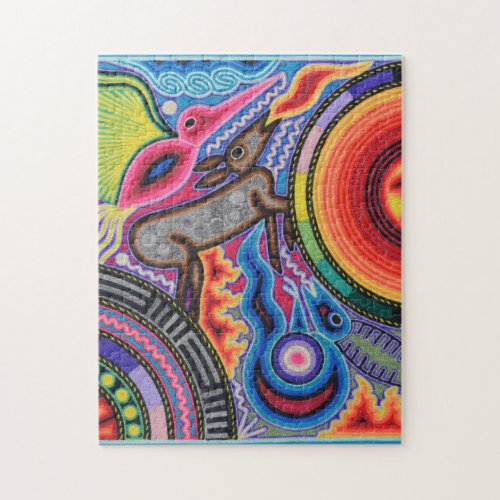Oaxaca Mexico Mexican Mayan Tribal Art Boho Travel Jigsaw Puzzle



Contact designer for assistance with personalization or special orders. The state of Oaxaca in southern Mexico has a noteworthy tradition of finely crafted textiles, particularly handmade embroidery and woven goods that frequently utilize a backstrap loom. Oaxaca is home to several different groups of indigenous peoples, each of which has a distinctive textile tradition. Oaxacan fibers may be hand spun from cotton or locally cultivated silk. Traditional dye sources include purpura pansa among the Huave, Chontal, and Mixtec people. The Chontal and Mazatec also utilize cochineal to attain bright red tones. According to Alejandro de Ãvila B., founding director of the Ethnobotanical Garden in Oaxaca, the region's biological diversity yields Mexico's greatest variety of fibers and dyes, and "the technical sophistication of Oaxaca's textiles is unparalelled in the country." Traditional clothing items among the peoples of Oaxaca include the huipil, a women's blouse constructed from several panels; the ceñidor, a type of sash among the Mazatec; and the paño, a Chinantec head covering. Handcrafted Oaxacan textiles employ plainweave, brocade patterns, gauze weave. Mexican textile expert Irmbard Weitlaner Johnson associates pre-Christian spiritual traditions with the presence of butterflies in Mazatec textile motifs. "To this day the Mazatecs identify the butterfly as the soul that leaves the body. They believe that the souls of the deceased have permission to come to this world once a year on All Saints' Day and the Day of the Dead to visit their family. This is the period when butterflies are most abundant in the area and the Mazatecs consider it a sin to kill them." Regional motifs without specific spiritual meaning, or for which disputed interpretations exist, include a class of stepped fret known as xicalcoliuhqui, which means "twisted ornament for decorating gourds" in the Nahuatl language; and the double spiral ilhuitl, whose name translates as "fiesta day." Pre-Colonial tradition associates color with the four cardinal directions: yellow with east, red with north, blue and green with west, and white with south. Another shared motif among the region's indigenous peoples is a rectangular ornament below the neckline of the huipil. No specific symbolism is known, but it is a frequent theme in pre-colonial codices and surviving historic textiles that remains in popular use. Traditionally, Oaxacan women wrap a red faja (a woven sash) around their waists as a protection from evil. [courtesy Wikipedia] Huichol Oaxacan Mexico Mexican Aztec Mayan Tribal Bohemian Boho Ethnic Oaxaca Colorful "Folk Art" Cheerful Colorful Hispanic Precolumbian Zapotec Mixtec Huave Chontal Mazatec Olmec Toltec Maya Goddess Quetzalcoatl "Feathered Serpent" Indigenous Native American Latin America Southwestern Western Textile Textiles Embroidery Embroidered Weaving Handwoven Beadwork Craft Crafts Village Naif Latino Latina Huipil Faja Pre-Colonial Ceñidor Paño New Mexico Santa Fe Taos Peasant Style Design Pattern Print Trend Trending Trendy Travel Traveler Well-Travelled Global Colorful Cheerful Sunny Sun Sol "Brillo del Sol" Bright Happy Primary Colors Color Green Gold Yellow Red Blue Fuschia Hot Pink Lime Black


